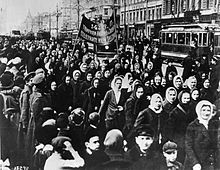
The October Revolution, known in Soviet historiography as the Great October Socialist Revolution, was a revolution in Russia led by the Bolshevik Party of Vladimir Lenin that was a key moment in the larger Russian Revolution of 1917–1923. It was the second revolutionary change of government in Russia in 1917. It took place through an armed insurrection in Petrograd on 7 November 1917 [O.S. 25 October]. It was the precipitating event of the Russian Civil War.

The Russian Revolution was a period of political and social change in the Russian Empire, starting in 1917. This period saw Russia abolish its monarchy and adopt a socialist form of government following two successive revolutions and a bloody civil war. The Russian Revolution can also be seen as the precursor for the other European revolutions that occurred during or in the aftermath of World War I, such as the German Revolution of 1918–1919.

Alexandra Mikhailovna Kollontai was a Russian revolutionary, politician, diplomat and Marxist theoretician. Serving as the People's Commissar for Welfare in Vladimir Lenin's government in 1917–1918, she was a highly prominent woman within the Bolshevik party. She was the first woman to be a cabinet minister, and the first woman ambassador.
Marxist feminism is a philosophical variant of feminism that incorporates and extends Marxist theory. Marxist feminism analyzes the ways in which women are exploited through capitalism and the individual ownership of private property. According to Marxist feminists, women's liberation can only be achieved by dismantling the capitalist systems in which they contend much of women's labor is uncompensated. Marxist feminists extend traditional Marxist analysis by applying it to unpaid domestic labor and sex relations.
Socialist feminism rose in the 1960s and 1970s as an offshoot of the feminist movement and New Left that focuses upon the interconnectivity of the patriarchy and capitalism. However, the ways in which women's private, domestic, and public roles in society has been conceptualized, or thought about, can be traced back to Mary Wollstonecraft's A Vindication of the Rights of Woman (1792) and William Thompson's utopian socialist work in the 1800s. Ideas about overcoming the patriarchy by coming together in female groups to talk about personal problems stem from Carol Hanisch. This was done in an essay in 1969 which later coined the term 'the personal is political.' This was also the time that second wave feminism started to surface which is really when socialist feminism kicked off. Socialist feminists argue that liberation can only be achieved by working to end both the economic and cultural sources of women's oppression.

Inessa Fyodorovna Armand was a French-Russian communist politician, member of the Bolsheviks and a feminist who spent most of her life in Russia. Armand, being an important figure in the pre-Revolution Russian communist movement and the early days of the communist era, had been almost forgotten for some time until the partial opening of Soviet archives during the 1990s. Historian Michael Pearson wrote about her: "She was to help him (Lenin) recover his position and hone his Bolsheviks into a force that would acquire more power than the tsar, and would herself by 1919 become the most powerful woman in Moscow."

The Zhenotdel (Женотдел), the women's department of the Central Committee of the All-Russian Communist Party (Bolsheviks), was the section of the Russian Communist party devoted to women's affairs in the 1920s. It gave women in the Russian Revolution new opportunities until it was dissolved in 1930.
Yedinstvo or Edinstvo was a faction within the Russian Social Democratic Labor Party (RSDLP) between 1914 and 1917 and then a small independent party in 1917 and 1918. It was led by Georgi Plekhanov.

State of Revolution is a two act play by Robert Bolt, written in 1977. It deals with the Russian Revolution of 1917 and Civil War, the rise to power of Vladimir Lenin, and the struggles of his chief lieutenants – namely Joseph Stalin and Leon Trotsky – to gain power under Lenin in the chaos of the Revolution.
All-Russian Union for Women's Equality was a liberal feminist organisation formed in the Russian Empire during the Russian Revolution of 1905. The Union demanded equal political, particularly voting, rights to women. The Union had main centers in Moscow and Saint Petersburg and a number of local chapters in various cities of the Empire. At its peak in 1906, the Union had 8,000 members and 78 branches in 65 cities. The Union published monthly magazine Women's Union in 1907–09. The Union disintegrated soon after the end of the revolution. Despite lack of tangible feminist achievements, the Union succeeded in raising awareness and political consciousness of many women in the Russian Empire.

Women in Russia have a rich and varied history during numerous regimes throughout the centuries. Since Russian society is multicultural, the experiences of women in Russia vary significantly across ethnic, religious, and social lines. The life of an ethnic Russian woman can be dramatically different from the life of women of minority groups like the Bashkirs and the life of a woman from a lower-class rural family can be different from the life of a woman from an upper-middle-class urban family. Nevertheless, a common historical and political context provides a framework for speaking about women in Russia in general.
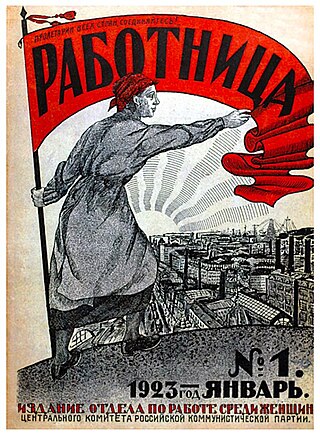
Rabotnitsa is a women's journal, published in the Soviet Union and Russia and one of the oldest Russian magazines for women and families. Founded in 1914, and first published on Women's Day, it is the first socialist women's journal, and the most politically left of the women's periodicals. While the journal's beginnings are attributed to Lenin and several women who were close to him, he did not contribute to the first seven issues.

Feminism in Russia originated in the 18th century, influenced by the Western European Enlightenment and mostly confined to the aristocracy. Throughout the 19th century, the idea of feminism remained closely tied to revolutionary politics and to social reform. In the 20th century Russian feminists, inspired by socialist doctrine, shifted their focus from philanthropic works to organizing among peasants and factory workers. After the February Revolution of 1917, feminist lobbying gained suffrage and general equality for women in society. Through this period the concern with feminism varied depending on demographics and economic status.
Kommunistka was a communist magazine from the Soviet Union, associated to the Zhenotdel, founded by Inessa Armand and Alexandra Kollontai in 1920.
Ekaterina Shchepkina (1854–1938) was a Russian and later Soviet feminist, historian and journalist.
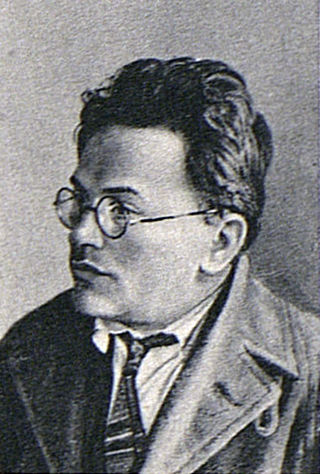
Georgy Ivanovich Safarov was a Bolshevik revolutionary and politician who was a participant in the Russian Revolution, the Russian Civil War, and in the executions of the Romanovs in Yekaterinburg and Alapayevsk.
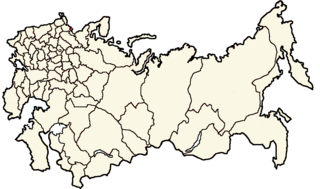
The Petrograd Metropolis electoral district was a constituency created for the 1917 Russian Constituent Assembly election. Petrograd city constituted an electoral district of its own, separate from the rest of the Petrograd Governorate. Voter turnout in the capital was estimated at between 69.7% and 72%.
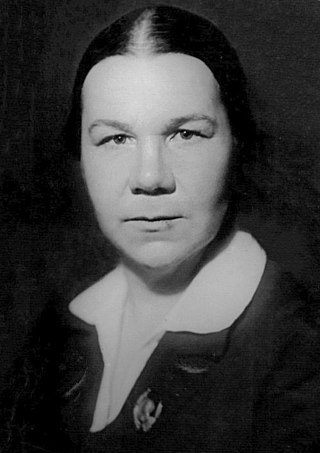
Klavdiya Ivanovna Nikolayeva was a Russian revolutionary, syndicalist, feminist, Old Bolshevik and Soviet politician. She was the second woman elected to the Bolshevik Secretariat, serving as a Candidate Member.

An index of articles related to the Russian Revolution and the Russian Civil War period (1905–1922). It covers articles on topics, events, and persons related to the revolutionary era, from the 1905 Russian Revolution until the end of the Russian Civil War. The See also section includes other lists related to Revolutionary Russia and the Soviet Union, including an index of articles about the Soviet Union (1922–1991) which is the next article in this series, and Bibliography of the Russian Revolution and Civil War.

Sofia Nikolaevna Smidovich was a Bolshevik revolutionary, feminist and the leader of the Zhenotdel from 1922 to 1924.

